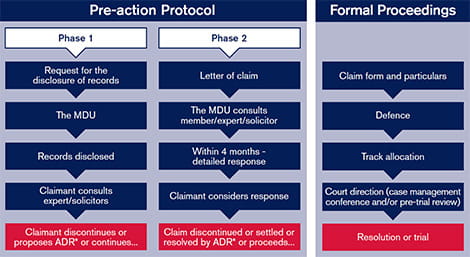To succeed in a claim of clinical negligence against a doctor, the patient (who becomes the claimant) has to prove on the balance of probabilities that:
- the doctor owed a duty of care
- there was a breach of that duty
- harm followed as a result (that is, causation is established).
How is breach of duty decided?
Your clinical management will be assessed by independent medical experts. They will use the Bolam standard, which means they will consider your clinical management against that of a responsible body of doctors practising in the same field.
Your management of the patient does not have to be the standard of the majority; it just has to be consistent with a responsible body of your professional peers. The onus is on the claimant to prove your management fell below the standard expected, and this caused the harm.
There is also a strong onus on experts to give reasonable and logical evidence about standards of care. A judge may decide not to accept an expert's view if that expert's evidence does not stand up to close scrutiny.
Timescale
In the civil justice system, the emphasis is on speed and efficiency. You must respond quickly if you're asked to disclose your records and the MDU must respond quickly to the claimant's solicitors.
After you have disclosed your notes there may be a long period when nothing seems to happen while the claimant takes advice and decides whether to proceed. This may be months or even years.
We will keep you informed if anything significant happens, but if you don't hear from us during this time, it's simply because we have nothing to report. However, you are always welcome to contact your MDU team at any time.
If the claimant decides to pursue the claim, once the formal process starts, the court will impose a strict timetable which you must follow.
The concept of 'limitation'
Formal proceedings must begin within three years. Otherwise, the case will become 'statute-barred' and can't be pursued any further. The three-year timescale can run from the date of the incident or from the date of knowledge, which may be some time later.
'Date of knowledge' is the date a patient becomes aware that their injury may be attributable, in whole or in part, to the alleged clinical negligence. This applies only to competent adult claimants.
After an initial exchange of correspondence, the claimant's solicitor should tell us if the matter will be pursued, and we'll pass this information on to you. However, this is not always a guarantee the claim has been discontinued; occasionally, another solicitor may take the case up on behalf of the claimant.
Remember, the court also has discretion to allow claims to proceed even though they have been issued outside the limitation period.
Children
The situation is different with children. By law, children have until their 21st birthday (that is, up to their 18th birthday plus three years) to issue proceedings. For example, a seven-year-old can wait for 14 years before beginning legal action. For those involved in the care of children there is the possibility, however remote, of receiving a claim brought by a child at any time up until the claimant's 21st birthday.
It may be that the claim can be brought even later if the patient is justifiably still unaware that a cause of action exists. Legal action is usually conducted on behalf of minors by a close relative who acts as their litigation friend.
Mental capacity
Time limits do not apply to patients who are deemed to lack competence to conduct their own affairs. For example, children with cerebral palsy after birth, or neurological damage following meningitis, and other brain-damaged patients, have no limitation on their claims. Formal proceedings may begin on their behalf at any time, regardless of the date of alleged negligence.
Milestones in the legal process
The civil procedure rules allow for flexibility and openness so both sides can be constructive about resolving the dispute. Mediation and arbitration may be used as part of the resolution process, as shown in the diagram below.

This page was correct at publication on 15/01/2020. Any guidance is intended as general guidance for members only. If you are a member and need specific advice relating to your own circumstances, please contact one of our advisers.